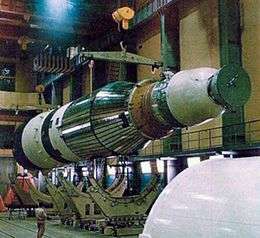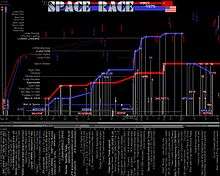Kosmos 146
 Image of a Zond rocket Model | |
| Mission type | Test flight Moon Race |
|---|---|
| Operator | Soviet space program |
| COSPAR ID | 1967-021A |
| SATCAT no. |
02705 |
| Mission duration | 8 day,est. |
| Orbits completed | N/A |
| Spacecraft properties | |
| Spacecraft type | 7K-L1 |
| Manufacturer | Experimental Design Bureau OKB-1 |
| Launch mass | 5017 kg |
| Start of mission | |
| Launch date | 10 March 1967 11:30:32 UTC |
| Launch site | Baikonur Tyuratam, Site 81, "Left" pad |
| End of mission | |
| Landing date | 22 March 1967 |
| Landing site | N/A |
| Orbital parameters | |
| Reference system | Circumlunar orbit |
| Periapsis | 177 kilometers (110 mi) |
| Apoapsis | 296 kilometers (184 mi) |
| Inclination | 51.44 |
| Period | 89.2 minutes |
|
Kosmos (satellite) (Manned missions) | |
Kosmos 146 was a Soviet test satellite precursor to the Zond series, launched from the Baikonur Cosmodrome aboard a Proton K rocket.[1] The spacecraft was designed to launch a crew from the Earth to conduct a flyby and return to earth.The primary focus was a Soviet circumlunar flight, which help document the moon, and also show Soviet power. The test ran from the Zond program from 1967-1970, which produced multiple failures in the 7K-L1’s re-entry systems. The remaining 7K-L1s were scrapped, ultimately replaced by the Soyuz 7K-L3[2][3]
Objectives
There are differing opinions about the goals and success of the mission "Kosmos-146". Most sources report that Kosmos 146 achieved escape velocity. The goal of Kosmos-146 could not have been to orbit the Moon, since time and place of the launch did not allow for such a trajectory.[4]
The engines of Block D were not started immediately, but only after about 8 orbits were completed, which is unusual. Reportedly some people claim that there are those who speculate that this delay was either meant to simulate the arrival of a separately launched crew at the Soyuz spacecraft, or not.
Moon race

By the time the device was launched, U.S.A had already thrust into the orbit in their prototype of the lunar vehicle ( AS-201 , AS-202 , AS-203 ). The US could go on to launch manned prototypes of lunar ships before the USSR brought the first unmanned prototype into orbit, but two months before the launch of Kosmos-146 during the fire in the command module, the crew of Apollo-1 was killed.
References
- ↑ Harvey, Brian (2007). Soviet and Russian Lunar Exploration. Springer Science & Business Media. p. 138. ISBN 9780387739762.
- ↑ Harvey, Brian (2007). Soviet and Russian Lunar Exploration. Springer Science & Business Media. p. 138. ISBN 9780387739762.
- ↑ "Cosmos 146". nssdc.gsfc.nasa.gov/. National Aeronautics and Space Administraion.
- ↑ Sven Grahn and Bart Hendrickx. "The continuing enigma of Kosmos 146 and Kosmos 154". svengrahn.pp.se. Sweden: Sven Grahn.
External links